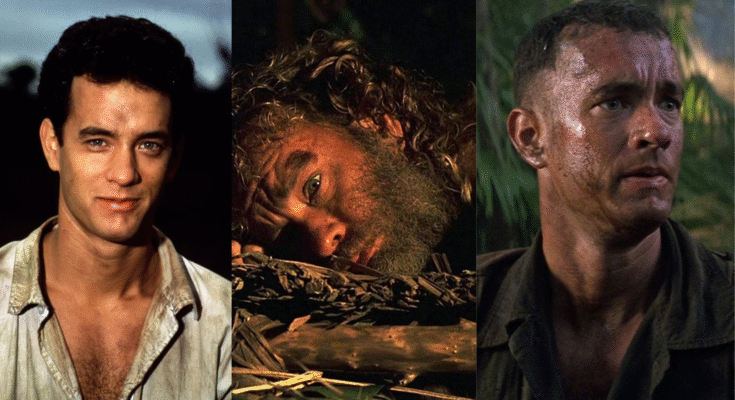The Heart Behind the Smile: Meet Tom Hanks
In a town full of beautiful people chasing stardom with calculated ambition, Tom Hanks succeeded by doing something radically different: He was genuinely kind, worked harder than everyone else, and treated acting like a craft, not a shortcut to fame.
His journey from struggling, unknown actor to the most beloved star in cinema is a masterclass in persistence, authenticity, and the power of simply being a good person in an industry built on ego.
How a Kid from Concord, California Became America’s Dad
The Complicated Beginning: Broken Homes and Constant Movement
July 9, 1956 – Thomas Jeffrey Hanks was born in Concord, California, to Amos Henry “Tom” Hanks Sr., a traveling salesman, and Janet Marylyn, a hospital worker.
His childhood was marked by something that deeply shaped him: instability.
Living in Chaos: When Home Isn’t Safe
Tom’s father was a traveling salesman constantly on the road. His mother worked long hours. The result was a household where:
Parents were rarely present at the same time
Tom felt the weight of his parents’ failing relationship
Security came from consistency that didn’t exist
He learned early that he couldn’t control what happened at home
The Divorce That Changed Everything:
Tom’s parents’ divorce hit him hard. At an age when most children want stability, Tom experienced the opposite. His parents separated, and he became a child caught between two households.
The Moving Years:
To escape the pain and difficulty, Tom and his family moved constantly:
California
Nevada
California again
Oregon
California yet again
By the time Tom was a teenager, he had attended nine different schools. Each move meant leaving friends, starting over, being the new kid again. The pain of constant transitions became his constant companion.
The Shy Kid Who Found Escape
In this chaotic environment, Tom discovered theater.
Theater as Survival:
School plays became his refuge
On stage, he could be someone other than the lonely kid with divorced parents
Acting let him process his emotions safely
Performance became his way of connecting with others
The stage was the only place that felt like home
This wasn’t ambition. This was survival. Tom wasn’t dreaming of Hollywood stardom. He was simply trying to make sense of his painful childhood.
The Invisible Years: Training in Obscurity
High School: The Awkward Years
Tom was not the popular kid. He was:
Awkward and gangly
Interested in theater when football was king
Bullied by classmates
Struggling with his identity
Fighting to understand why his family was broken while others seemed normal
But theater gave him something: a community that accepted him.
College: Building the Foundation
After high school, Tom attended Skyline College in Oakland, California, then transferred to California State University, Sacramento, where he majored in drama.
The Commitment:
Took acting seriously as a craft
Studied theater history and technique
Performed in student productions
Began to understand acting as more than escape—it was art
Developed the discipline that would define his career
The Key Realization: Tom understood that good acting requires work. It’s not about being beautiful or charismatic. It’s about understanding humanity deeply and expressing it truthfully.
Early Career: The Struggle (1978-1985)
After college, Tom moved to New York with dreams of becoming an actor. What followed was brutal:
The Harsh Reality:
Auditioned constantly, faced rejection relentlessly
Couldn’t book significant roles for years
Worked as a bellhop, deckhand, and parking attendant to pay rent
Lived in poverty while pursuing his dream
Watched less talented actors book roles he wanted
Questioned whether he was good enough
The Survival Jobs:
Worked at a psychiatric hospital where he gained insight into human psychology
Took temporary work constantly to support his acting
Never made enough money to feel secure
Lived with the constant anxiety of potentially giving up
The Turning Point: In the early 1980s, Tom finally started booking small television roles:
Guest appearances on sitcoms
Small parts in TV movies
Nothing that paid well
Nothing that led anywhere obvious
But something.
The Real Test: Tom had a choice. He could give up and get a real job. He was in his late 20s. Success wasn’t guaranteed. Most people would quit.
But Tom didn’t quit.
The Breakthrough: When Persistence Met Opportunity
“Splash” (1984): The Unexpected Beginning
At age 28, Tom got a role that seemed insignificant at the time: playing opposite Daryl Hannah in “Splash,” a romantic comedy about a man who falls in love with a mermaid.
It wasn’t a prestige film. It wasn’t serious drama. It was a silly romantic comedy that could have been a career dead-end.
What Tom Did: Instead of phoning it in, he brought genuine warmth and humor to the role. He made the audience believe in the impossible romance. He was likeable, funny, and authentic.
The Results:
The film was a surprise hit
Tom’s charm and likability stood out
Audiences connected with him immediately
The film grossed over $200 million worldwide
Tom Hanks suddenly wasn’t unknown anymore
The Real Lesson: Tom understood something crucial: There are no small roles, only small actors. He treated every opportunity as if it mattered, because it did.
The Build: Smart Choices (1985-1993)
Instead of resting on the success of “Splash,” Tom made intelligent career decisions:
Romantic Comedies:
“Bachelor Party” (1984) – Comedy success
“The Money Pit” (1986) – Learning timing and physical comedy
“Sleepless in Seattle” (1993) – Romantic comedy masterpiece
Drama:
“Big” (1988) – Breakthrough performance as a child in an adult’s body
“Turner & Hooch” (1989) – Comedy-drama with heart
“A League of Their Own” (1992) – Period comedy-drama
The Strategy: Tom wasn’t trying to be an action star or a dramatic actor. He was being himself—likeable, warm, funny, and human. He was building credibility and audience trust.
Every film taught him something. Every role expanded his range.
The Turn: From Likeable to Legendary (1994-2000)
Then something shifted. Tom made the decision to challenge himself with more serious material:
“Forrest Gump” (1994):

Academy Award winning role
Played a man with developmental disabilities with dignity and warmth
Showed emotional depth beyond comedy
Made audiences cry and believe in redemption
Proved he was more than a charming romantic lead
Won the Academy Award for Best Actor
Grossed over $678 million worldwide
“Apollo 13” (1995):
True story about the moon mission gone wrong
Played the steady, heroic astronaut
Showed leadership and composure under pressure
Critical acclaim across the board
“Saving Private Ryan” (1998):
WWII epic about the D-Day invasion
Played a war-torn captain leading his men through hell
Raw, powerful, devastating performance
Changed the way war films were made
Grossed over $480 million worldwide
Showed Tom could carry massive, serious productions
“You’ve Got Mail” (1998):
Romantic comedy proving he hadn’t abandoned the genre that made him
Showed he could do romance with intelligence and wit
Grossed over $300 million worldwide
“The Green Mile” (1999):
Drama about death row prison guards
Emotional, powerful, deeply human
Collaborated with director Frank Darabont who would become a frequent collaborator
Nominated for Academy Award
The Result: By 2000, Tom Hanks had proven something unprecedented: He could do anything. Comedy, drama, action, romance—he excelled at everything.
More importantly, audiences didn’t just watch his films. They believed in him. Tom Hanks became synonymous with trustworthiness and authenticity.
The Golden Era: Icon Status (2000-2020)
Box Office Dominance
From 2000 onwards, Tom Hanks became one of the most bankable stars in cinema:
Blockbuster Success:
“Cast Away” (2000) – $429 million, survival drama masterpiece
“Road to Perdition” (2002) – Crime drama with emotional depth
“The Terminal” (2004) – Quirky drama with warmth
“The Da Vinci Code” (2006) – Mystery thriller, $758 million worldwide
“Angels & Demons” (2009) – Sequel success
“Toy Story 3” (2010) – Voice acting excellence
“The Post” (2017) – Political thriller
“Saving Mr. Banks” (2013) – Backstage Hollywood drama
“Bridge of Spies” (2015) – Cold War thriller
The Numbers:
Consistently in the top 10 highest-grossing films annually
Multiple films grossing over $500 million worldwide
Few films that didn’t turn a profit
Became one of the most reliable movie stars ever
The Real Achievement: Beyond Money
But Tom’s success wasn’t just about box office numbers. It was about something deeper:
Cultural Trust:
Parents felt comfortable taking their children to Tom Hanks films
He was never involved in scandal or controversy
Audiences knew what they would get: quality, sincerity, and excellence
He became America’s Dad
Critical Respect:
Oscar nominations for acting talent, not just popularity
Directors competed for Tom Hanks for their projects
Critics took his roles seriously
He was respected as an artist, not just a celebrity
Consistency:
40+ years of appearing in quality films
Rarely made a bad film or poor choice
Maintained standards when it would have been easier to cash in
Built a filmography that endures
The Secret Behind Tom Hanks’ Immortal Success
Lesson 1: Kindness Is a Strategic Advantage
Tom Hanks is famous for his genuine kindness:
Treats crew members with respect and warmth
Remembers people’s names and personal details
Shows up early and stays late
Makes everyone around him feel valued
Creates a positive work environment wherever he goes
The Result: People want to work with him. Directors lobby for him. Crews are energized by his presence.
Lesson 2: Treat Every Role as if It Matters
Whether it’s a voice role in an animated film or a lead in an Oscar-bait drama, Tom approaches every role with the same dedication:
Full preparation and research
Respect for the craft
Commitment to authenticity
Refusal to phone it in
The Result: Every Tom Hanks film is better because he’s in it.
Lesson 3: Authenticity Beats Charisma
Tom isn’t the most classically handsome actor. He’s not the most charismatic in the traditional sense. But he’s genuine.
He doesn’t pretend to be someone he’s not. He brings himself to every role—his humor, his warmth, his humanity. This authenticity is magnetic.
Lesson 4: Versatility Proves Mastery
Rather than settling into one type of role, Tom pushed himself across genres:
Comedy, drama, action, romance, animation, thriller
Leading man, supporting player, voice actor
Contemporary and historical stories
Light entertainment and serious art
The Result: No one could typecast him. He remained interesting and unpredictable.
Lesson 5: Build Your Career on Trust, Not Celebrity
Tom didn’t pursue fame. He pursued good work. Fame followed.
He never tried to be cooler or edgier. He remained fundamentally decent, fundamentally committed to craft, fundamentally focused on telling good stories.
The Result: That trustworthiness became his greatest asset.
Personal Life: Staying Grounded
Marriage and Family
Rita Wilson:
Married actress Rita Wilson in 1988

Their marriage has lasted 35+ years
Raised children together while maintaining demanding careers
Kept their family life largely private despite fame
The Example: In an industry full of divorces and scandals, Tom and Rita’s stable, enduring marriage became almost revolutionary. It showed that Hollywood stardom doesn’t require drama or broken relationships.
Staying Out of Controversy
Tom Hanks has:
Never been involved in major scandal
Avoided destructive behavior
Kept his personal life private
Focused on his work rather than celebrity gossip
Been a steady, reliable presence in Hollywood
The Result: His reputation remains unblemished after 45 years of public life.
The Awards and Recognition: By the Numbers
Academy Awards:
2 wins (consecutive wins in 1994 and 1995 for “Forrest Gump” and “Apollo 13”)
8 nominations across acting and production
Golden Globes:
7 wins
30+ nominations
Emmy Awards:
Wins for television work
BAFTA Awards:
Multiple wins and nominations
The AFI Life Achievement Award:
Recognition as one of cinema’s greatest legends
Honorary Knighthood:
Granted by the British government for his cultural contributions
The Real Measure: These aren’t just awards. They represent consistent excellence across five decades and multiple formats.
Tom Hanks During Crisis: The COVID-19 Pandemic (2020)
A Different Kind of Role
In March 2020, Tom Hanks and Rita Wilson announced they had tested positive for COVID-19 while filming in Australia.
His Response:
Stayed silent and didn’t sensationalize the diagnosis
Recovered and gradually returned to work
Used his platform to encourage responsible behavior
Didn’t turn his illness into a publicity stunt
Simply moved forward
The Significance: Even during a global crisis, Tom Hanks remained measured, responsible, and focused on doing the right thing. He didn’t make it about him.
The Journey: Before & After
AspectThe Struggling Actor (1978-1983)The Living Legend (1994-Present)
Financial Status
Poverty, survival jobs
Multi-billionaire
Career Status
Unknown, facing rejection
Most bankable star
Recognition
None
Global icon
Opportunities
Fighting for any role
Choosing from top projects
Trust Level
Unknown
Highest in industry
Box Office Power
None
$9+ billion grossing films
Awards
None
2 Oscars, 7 Golden Globes
Industry Respect
Minimal
Universal respect
Career Stability
Uncertain future
Legendary legacy
Cultural Impact
Minimal
Defining American cinema
The Bottom Line: Why Tom Hanks’ Story Matters
Tom Hanks didn’t become the world’s most beloved star through scandals, sex appeal, or shortcuts. He became beloved through:
✓ Relentless work ethic and persistence through years of rejection ✓ Treating every role with respect and commitment ✓ Remaining genuinely kind in an unkind industry ✓ Building trust through consistency and authenticity ✓ Refusing to compromise on quality ✓ Staying grounded despite enormous success ✓ Prioritizing family and genuine relationships ✓ Using his platform responsibly ✓ Proving that decency and excellence aren’t obstacles to success—they’re pathways to it
Key Takeaways for Strivers and Dreamers
🎬 Hard work and persistence eventually overcome initial rejection 🎬 Treating people with kindness creates loyalty and opportunity 🎬 Every role matters—there are no small parts, only small actors 🎬 Authenticity is more magnetic than charisma 🎬 Versatility keeps you interesting across decades 🎬 Trust is the most valuable currency in any industry 🎬 Consistency matters more than individual moments 🎬 Family and relationships shouldn’t be sacrificed for career 🎬 Staying out of drama allows your work to speak 🎬 True success is built over decades, not overnight
Tom Hanks’ Defining Words
“If it wasn’t hard, everyone would do it. It’s the hard that makes it great.”
“The most important thing is the mission. And the mission is to tell the story in the most honest and compelling way.”
“We all want to be extraordinary. But we don’t want to do extraordinary things.”
“The things we have to work for are the things that matter.”
The Continuing Legacy
In his late 60s, Tom Hanks continues to work on projects he believes in:
Productions through his company Playtone
Documentary narration
Selective film appearances
Voice work for major animated films
Mentorship of younger actors
He hasn’t retired because his passion for storytelling hasn’t diminished. If anything, decades of experience have deepened his understanding of what makes a great story.
This is the real Tom Hanks story:
Not a man who became a star and disappeared into excess. But a man who:
Survived a broken childhood through art
Persisted through years of rejection
Built an incomparable career through excellence
Remained genuinely kind despite unlimited power
Showed that decency and success aren’t contradictory
Proved that authenticity endures longer than any trend
Created a legacy that will influence cinema for generations
That’s not just stardom. That’s immortality.
That’s Tom Hanks.



